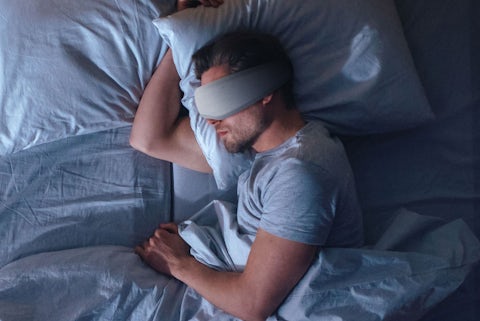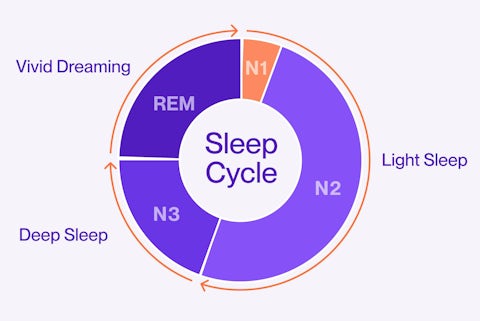What is Microsleep – Causes, Risks, and Treatment
 Andrew Jolie April 22, 2024 8 min read
Andrew Jolie April 22, 2024 8 min read
Have you ever blinked and suddenly realized you missed a few seconds? That’s microsleep—an often involuntary lapse in consciousness that can affect anyone, especially if sleep-deprived or doing monotonous tasks. Although brief, microsleep can be dangerous, particularly when driving or operating machinery. Let’s explore its causes, symptoms, risks, and how to manage or prevent it to stay alert and safe.
What is Microsleep?
Microsleep refers to those short moments when your brain takes a small but unplanned break from being awake, even though it might seem like you’re awake to other people. During microsleep, you experience a sudden lapse in attention, and your eyes may even stay open.
These episodes can last from just a fraction of a second to about 30 seconds. While they often happen when you're tired, they can catch you off guard during long, monotonous activities like driving on an open highway or staring at a computer screen for hours. Understanding these mini-sleep episodes is important, as they can provide clues about your overall sleep health and alertness.
Microsleep Symptoms
Recognizing the signs of microsleep can help you identify when you or someone else is experiencing these brief lapses in wakefulness. Here are some common symptoms to watch for:
- Sudden Body Jerks: An involuntary muscle twitch or a sudden jolt can often indicate the onset of microsleep.
- Blank Stares: If you find yourself staring blankly into space or your eyes glaze over, it might be a sign that you've just experienced microsleep.
- Nodding Off: The head nodding as if in agreement or nodding slowly as if dozing off is a classic indicator of microsleep.
- Blinking Slowly: Prolonged eye closure or slow blinking can suggest that microsleep episodes are happening.
- Memory Gaps: Not remembering the last few seconds or missing a turn while driving can be a symptom of microsleep.
- Difficulty Focusing: If concentrating on a task becomes unusually hard or you can’t keep track of what you were just doing, microsleep could be the culprit.
Awareness of these symptoms is crucial, especially when alertness is non-negotiable, like driving or operating heavy machinery. That can be extremely dangerous.
What Causes Microsleep?
Microsleep is primarily caused by sleep deprivation, but several other factors and conditions can also lead to these brief lapses in consciousness. Understanding the triggers can help you manage or prevent microsleep episodes. Here are some common causes:
- Sleep Deprivation: The most significant factor leading to microsleep. Missing even a few hours of sleep can increase the risk.
- Monotonous Tasks: Engaging in activities that require prolonged attention but minimal cognitive engagement, like driving long distances on a straight road or monitoring surveillance footage.
- Irregular Sleep Schedules: Shift work or irregular sleeping patterns disrupt the body’s natural circadian rhythm, making microsleep more likely.
- Sleep Disorders: Conditions such as narcolepsy, sleep apnea, and insomnia can cause fragmented sleep, which may lead to microsleep during waking hours.
- Medications: Some prescription medications that induce drowsiness or affect sleep patterns can trigger microsleep.
- Alcohol Consumption: Alcohol impairs sleep quality and can increase the frequency of microsleep episodes, especially if consumed before performing tasks requiring alertness.
By being aware of these causes, you can take steps to minimize the risk of experiencing microsleep, ensuring better safety and performance during daily activities.
Is Microsleep Dangerous?
Microsleep can be extremely hazardous, especially when it happens during activities that demand constant attention and quick reactions. Here's why microsleep poses significant risks:
- Accidents and Errors: Microsleep episodes can lead to serious mistakes in almost any activity, from misjudging driving distances to making mistakes in operating heavy machinery.
- Driving Dangers: Microsleep while driving is especially dangerous. It only takes a few seconds of dozing off to drift off the road or into another lane, potentially causing a high-speed collision.
- Workplace Incidents: In work environments, particularly in roles that involve operating complex machinery or performing critical tasks, a few seconds of inattention can lead to accidents, affecting not just the person but also others around them.
Microsleep While Driving
- Loss of Vehicle Control: Microsleep can cause drivers to lose control of their vehicle, leading to swerving, sudden braking, or failure to respond to road signals.
- Delayed Reaction Times: Even a brief lapse can significantly delay a driver's reaction time, which is critical in avoiding road hazards or adjusting to sudden changes in traffic.
- Legal and Financial Consequences: Falling asleep at the wheel, even momentarily, can lead to legal repercussions, including fines or more severe penalties, especially if it results in an accident.
No question about it, microsleep is a super dangerous thing to happen.
What Occurs During Microsleep?
During a microsleep episode, several physiological processes temporarily disconnect you from your usual state of alertness. Here’s a breakdown of what happens in the body and brain during these brief lapses:
- Brain Activity Reduction: The brain experiences a sudden drop in activity in regions responsible for attention and alertness. This decrease mimics the patterns seen during the initial stages of sleep.
- Thalamus Involvement: The thalamus, a part of the brain that regulates sleep and wakefulness, partially shuts down, leading to a brief cessation of sensory information being processed. This is why you might not respond to external stimuli during microsleep.
- Autopilot Mode: Even as parts of the brain take a quick nap, other areas, particularly those involved in automatic functions, remain active. This allows some individuals to continue performing simple tasks or maintaining a posture, albeit often less effectively.
- Eye Behavior: There's typically a disconnection between eye movements and focus. Eyes might remain open but stop tracking properly, resulting in a blank stare or slow blinking.
- Memory Lapse: Since the brain is not fully processing new information during microsleep, there can be a noticeable gap in memory from right before or after the episode.
How to Stop Microsleep
Preventing microsleep starts with understanding and mitigating its causes. Here are several practical tips and strategies to reduce the likelihood of experiencing microsleep episodes, especially in situations staying alert is vital:
- Prioritize Adequate Sleep: Ensure you get at least 7-9 hours of quality sleep each night to minimize fatigue during the day.
- Maintain Regular Sleep Schedules: Try to go to bed and wake up at the same time every day, even on weekends, to keep your body's internal clock regular.
- Take Short Naps: If you're feeling drowsy, especially before driving or engaging in another focus-intensive activity, a short nap (about 20 minutes) can help refresh your alertness.
- Monitor Sleep Quality: If you consistently feel tired despite getting enough sleep, consider evaluating your sleep quality and discussing potential sleep disorders with a healthcare provider.
- Create Engaging Activities: Break up long periods of monotonous activity with more engaging or varied tasks to keep your brain active and alert.
- Use Caffeine Wisely: A moderate amount of caffeine can help enhance alertness. However, it should not be relied on as a substitute for adequate sleep.
- Stay Hydrated and Eat Healthily: Dehydration and poor diet can exacerbate tiredness. Drinking water and eating nourishing foods help maintain energy levels.
- Recognize the Signs: Being aware of the signs of microsleep can help you take action before an episode occurs, such as pulling over to rest if you’re driving.
Can Microsleep Be Controlled?
Controlling microsleep starts with good sleep habits—ensuring you're well-rested is key to staying alert. Creating a restful sleeping environment and adhering to a regular sleep schedule are crucial, especially for those with irregular hours like night shift workers or long-haul drivers. Incorporating quick naps during breaks can also help sharpen focus. Additionally, maintaining a healthy lifestyle with regular exercise and balanced meals helps keep energy levels steady, reducing the risk of unexpected sleepiness. Recognizing the signs of microsleep and undergoing fatigue management training can further equip individuals in high-risk jobs to prevent these involuntary sleep episodes effectively.
What is Micro-napping?
Micro-napping involves short, intentional naps that rejuvenate your mind and body when you're tired. Unlike involuntary microsleep, micro-napping is a conscious decision that helps boost alertness, ideal for those with demanding schedules like truck drivers or students during exams. While micro-naps are proactive tools for managing fatigue, microsleep signals severe sleep deprivation. Incorporating micro-naps can help avoid the risks of microsleep, ensuring better safety and effectiveness.
FAQs About Microsleep
Is microsleep good or bad?
Microsleep is generally considered problematic because it indicates inadequate rest and can pose significant safety risks, particularly during activities that demand constant attention like driving or operating machinery.
Do you dream during microsleep?
Dreaming during microsleep is unlikely because these brief lapses are too short to reach the REM (Rapid Eye Movement) sleep phase where most dreaming occurs.
What happens in the brain during microsleep?
During microsleep, there's a significant reduction in brain activity in areas responsible for maintaining alertness and processing sensory information. This temporary shutdown leads to lapses in consciousness and attention.
Why does microsleep feel good sometimes?
Sometimes microsleep can feel good because it offers a brief respite for the brain, especially when you're exhausted. It acts like a mini-break during overwhelming fatigue, momentarily easing the body's urgent need for sleep.


